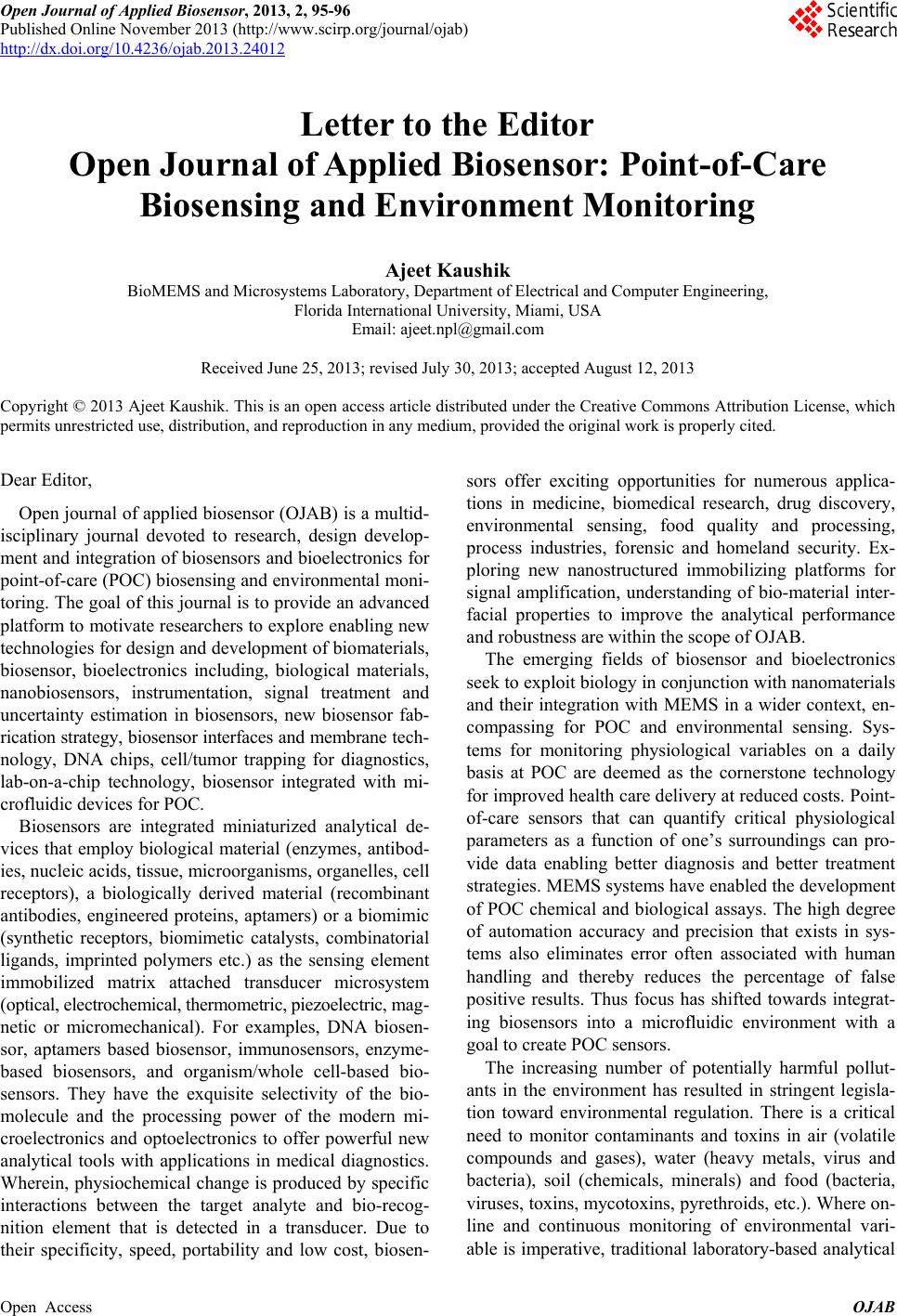Paper Menu >>
Journal Menu >>
 Open Journal of Applied Biosensor, 2013, 2, 95-96 Published Online November 2013 (http://www.scirp.org/journal/ojab) http://dx.doi.org/10.4236/ojab.2013.24012 Open Access OJAB Letter to the Editor Open Journal of Applied Biosensor: Point-of-Care Biosensing and Environment Monitoring Ajeet Kaushik BioMEMS and Microsystems Laboratory, Department of Electrical and Computer Engineering, Florida International University, Miami, USA Email: ajeet.npl@gmail.com Received June 25, 2013; revised July 30, 2013; accepted August 12, 2013 Copyright © 2013 Ajeet Kaushik. This is an open access article distributed under the Creative Commons Attribution License, which permits unrestricted use, distribution, and reproduction in any medium, provided the original work is properly cited. Dear Editor, Open journal of applied b iosensor (OJAB) is a multid- isciplinary journal devoted to research, design develop- ment and integration of biosensors and bioelectronics for point-of-care (POC) biosensing and environmental moni- toring. The goal of this jou rnal is to provide an advanced platform to motivate researchers to explore enabling new technologies for design and development of biomaterials, biosensor, bioelectronics including, biological materials, nanobiosensors, instrumentation, signal treatment and uncertainty estimation in biosensors, new biosensor fab- rication strategy, biosensor interfaces and membrane te ch- nology, DNA chips, cell/tumor trapping for diagnostics, lab-on-a-chip technology, biosensor integrated with mi- crofluidic devices for POC. Biosensors are integrated miniaturized analytical de- vices that employ biological material (enzymes, antibod- ies, nucleic acids, tissue, microorgan isms, organelles, cell receptors), a biologically derived material (recombinant antibodies, engineered proteins, aptamers) or a biomimic (synthetic receptors, biomimetic catalysts, combinatorial ligands, imprinted polymers etc.) as the sensing element immobilized matrix attached transducer microsystem (optical, el ect roc hem ical, t he rmom etric , pi ezoel ect ric , mag- netic or micromechanical). For examples, DNA biosen- sor, aptamers based biosensor, immunosensors, enzyme- based biosensors, and organism/whole cell-based bio- sensors. They have the exquisite selectivity of the bio- molecule and the processing power of the modern mi- croelectronics and optoelectronics to offer powerful new analytical tools with applications in medical diagnostics. Wherein, physiochemical change is produced by specific interactions between the target analyte and bio-recog- nition element that is detected in a transducer. Due to their specificity, speed, portability and low cost, biosen- sors offer exciting opportunities for numerous applica- tions in medicine, biomedical research, drug discovery, environmental sensing, food quality and processing, process industries, forensic and homeland security. Ex- ploring new nanostructured immobilizing platforms for signal amplification, understanding of bio-material inter- facial properties to improve the analytical performance and robustness are within the scope of OJ A B. The emerging fields of biosensor and bioelectronics seek to exploit biology in conjunction with nanomaterials and their integration with MEMS in a wider context, en- compassing for POC and environmental sensing. Sys- tems for monitoring physiological variables on a daily basis at POC are deemed as the cornerstone technology for improved health care delivery at reduced costs. Point- of-care sensors that can quantify critical physiological parameters as a function of one’s surroundings can pro- vide data enabling better diagnosis and better treatment strategies. MEMS systems have enabled the development of POC chemical and biological assays. The high degree of automation accuracy and precision that exists in sys- tems also eliminates error often associated with human handling and thereby reduces the percentage of false positive results. Thus focus has shifted towards integrat- ing biosensors into a microfluidic environment with a goal to create POC sensors. The increasing number of potentially harmful pollut- ants in the environment has resulted in stringent legisla- tion toward environmental regulation. There is a critical need to monitor contaminants and toxins in air (volatile compounds and gases), water (heavy metals, virus and bacteria), soil (chemicals, minerals) and food (bacteria, viruses, toxins, mycotoxins, pyrethroids, etc.). Where on- line and continuous monitoring of environmental vari- able is imperative, traditional laboratory-based analytical  A. KAUSHIK 96 methods will not suffice. POC systems driven by bio- sensor integrated microfluidic technology is a key player in the realization of such environmental sensors. For the success and to maintain consistency within the scope of the OJAB, the journal will accept reviews, re- search papers, short communication and technical notes which describe enabling technologies, new sensing stra- tegies, new diagnostic tool, bio-chips, miniaturized bio- medical devices with new concepts and understanding of the research field with the real application and commer- cial prospects. Open Access OJAB |

